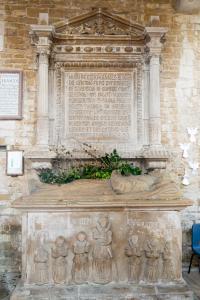Frieze
Frieze is in Architectural Detail.
On 19 Sep 1580 Catherine Willoughby Duchess Suffolk (age 61) died. Her son Peregrine Bertie 13th Baron Willoughby (age 24) succeeded 13th Baron Willoughby de Eresby. Mary Vere Baroness Willoughby of Eresby by marriage Baroness Willoughby de Eresby.


She was buried at St James' Church, Spilsby [Map] with her second husband Richard Bertie Baron Willoughby (age 63). Elizabethan Period. Sideboard Tomb. Cornice supported by three figures of a monk and two wildmen, each holding aloft a shield of arms. In the frieze are flowers, fruit and escutcheons.
Mary Vere Baroness Willoughby of Eresby: she was born to John de Vere 16th Earl of Oxford and Margery Golding Countess of Oxford. On 25 Dec 1577 Peregrine Bertie 13th Baron Willoughby and she were married. She the daughter of John de Vere 16th Earl of Oxford and Margery Golding Countess of Oxford. He the son of Richard Bertie Baron Willoughby and Catherine Willoughby Duchess Suffolk. Around 24 Jun 1624 Mary Vere Baroness Willoughby of Eresby died.
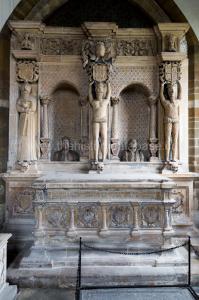
On 29 Aug 1582 Thomas St Paul died. He was buried at St Lawrence's Church, Snarford [Map]. Monument to Thomas St Paul and Faith Grantham. Fine freestanding tomb chest with canopy. The sides of the tomb chest have acanthus Pilasters, the panels between contain wreathed shields. The full length recumbent albaster effigies show the man in full plate armour holding sword and prayerbook, head on helm, feet on a cushion with flowers. His wife is in a long dress with cloak and close fitting hat, holding a bible. The inscription runs round the top edge of the chest. The canopy is supported on six pillars, those at the angles being circular and bulbous, the others in the form of obelisks decorated with fishscale Paterae, with elaborate Ionic Capitals with roses in the necking. The entablature has an egg and dart frieze. Above the heads of the columns are five female and one male weepers. At the centre of the canopy is a raised altar bearing shields and surmounted by the kneeling figure of the heir clad in armour. In front kneels a larger figure of a girl. the monument is all painted and gilded.
Thomas St Paul: he and Faith Grantham were married. he was appointed High Sheriff of Lincolnshire. In 1580 Thomas St Paul was knighted by Queen Elizabeth I of England and Ireland at Richmond, Surrey.
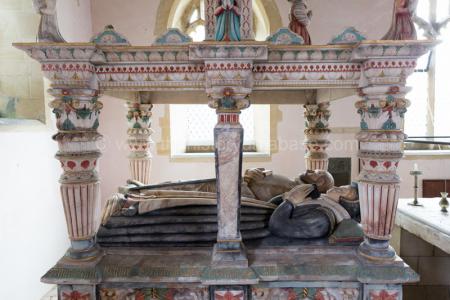
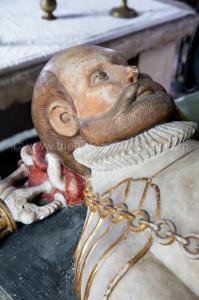

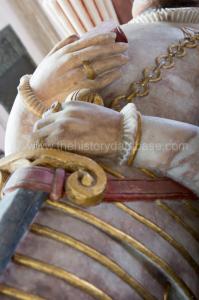
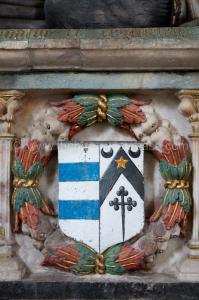
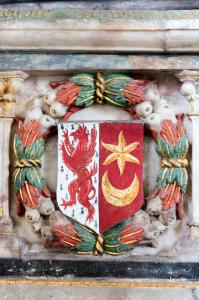
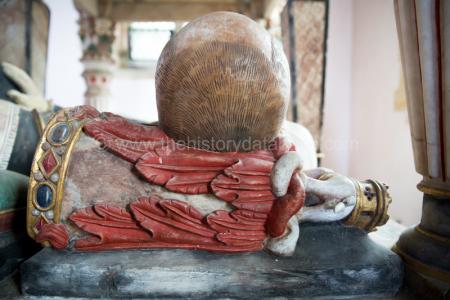
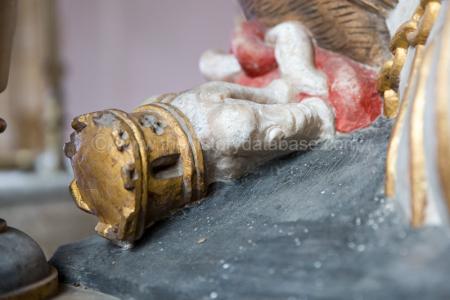
After 28 Oct 1613. Monument to George St Paul 1st Baronet (deceased) and Frances Wray Countess Warwick. at St Lawrence's Church, Snarford [Map]. Elizabethan Period. A base supporting the reclining figures of the deceased with composite Pillars supporting an entablature and armorial termination. In the base is a central semi-circular niche containing a carving of the deceased's daughter, flanked by niches containing mourning putti. Above on the lower step is a figure of Frances in full mourning dress with formal Ruff and hat, reclining on a cushion holding a prayer book. On the upper step he reclines in plate armour with a sword. The figures are contained in a semi-circular headed Recess with roses in the archivolt and on the back wall is an inscribed rectangular panel with scrolls and memento mori. The Pillars to either side support a frieze and entablature from which rise flaming urns and at the angles, and at the centre is a raised achievement of arms flanked by scrolled shields and obelisks. Possibly sculpted by Cornelius Cure.
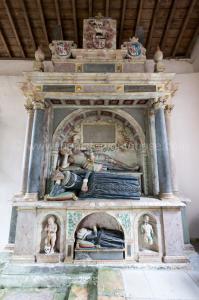
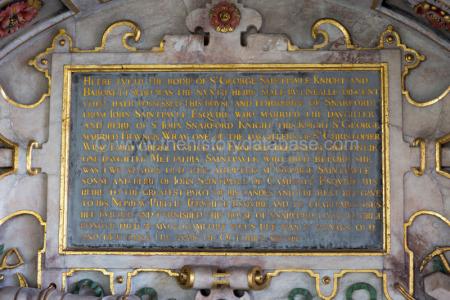
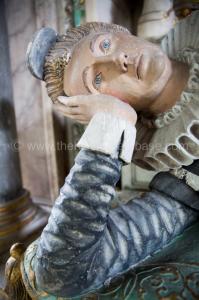
On 11 Sep 1617 Anthony Mildmay (age 68) died. He was buried at the Church of St Leonard, Apethorpe [Map]. His inscription reads ... Here sleepeth in the Lord with certaine hope of resurection Sr Antony Mildmay Knt eldet sonne to Sr Walter Mildmay Knt Chaunclor of the Exchequor. to Queene Elizabeth. He was Embassador from Queen Eliza: to the most Christian King of Fraunce Henry the 4th Ano. 1596; He was to Prince and Country faithful, and serviceable, in peace and warre, to freinds constant to enemies reconciliable. Bountiful and loved hospitality. He died September 11 1617.
On 27 Jul 1620 Grace Sharington (age 68) died. She was buried at the Church of St Leonard, Apethorpe [Map]. The inscription of her monument reads ... Here also lyeth Grace Ladie Mildmay the only wife of the saied Sr Antho: Mildmay one of the heyres of Sr Henry Sharington Knt: of Lacock in the County of Wiltes who lived 50 years maried to him and three years a widow after him. she was most devout, unspotedly chast mayd, wife, and widow, compassionate in heart, and charitably helpful with phisick, cloathes, nourishment, or counsels to any in misery, She was most careful and wise in managing worldly estate. So as her life was a blessing to hirs, and hir death she blessed them which hapned July 27 1620.
From RCHME Inventory. It is of grey veined and black marble and is partly gilded and painted. Two effigies lie on a black and white marble tomb chest beneath a baldachino consisting of a shallow dome with a cupola having round-headed openings in its drum, which give light to the interior. The baldachino is supported at each end by a rectangular pier onto which curtains, hanging from the architrave of the dome, are looped. Against the piers are standing figures representing the four Virtues, and the frieze is inscribed 'Devoute', 'Wise', 'Charitable' and 'Just'; the frieze is also inscribed 'Chaste' and 'Valiant'. The head of the figure representing Justice is modern. Seated on the cornice are smaller figures, on the E. of Faith and on the W. of Hope; on the cupola dome is a seated figure of Charity. Crowning the cornice are freestanding cartouches of arms of Mildmay (N.E. and S.E.) and Sherington (N.W. and S.W.). Against the cupola drum are shields of arms of Mildmay impaling Sherington, both quartered with alliances, and Mildmay quarterly. The W. pier of the baldachino is inscribed with a record of the setting up of the monument by Sir Francis Fane (age 37) in 1621. The tomb chest is enriched with emblems of mortality and eulogistically-phrased inscriptions record the lives of Sir Anthony on the S., and of Lady Grace on the N. The effigies lie on rush mats, he in Greenwich armour, she in full mantle, ruff and head-dress. The authorship of the monument is not known but the figures of the four Virtues are in the manner of Maximillian Colt (age 42) (cf. Cecil monument, Hatfield, Hertfordshire); the baldachino may be compared with that over the tomb of the Countess of Derby at Harefield, Middlesex, probably also by Colt (age 42).
Grace Sharington: Around 1552 she was born to Henry Sharington of Lacock in Wiltshire and Anne Paggett of Lacock Abbey. In 1567 Anthony Mildmay and she were married. They lived at Apethorpe Hall, Northamptonshire. In 1581 Henry Sharington of Lacock in Wiltshire died. His two surviving daughters for many disputed his will. According to Grace Sharington her sister Olive Sharington had persuaded their father to change his will. Grace Sharington eventually gained an equal share.
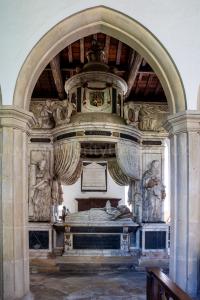
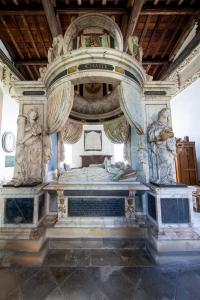
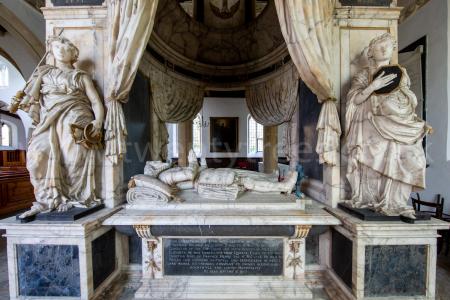
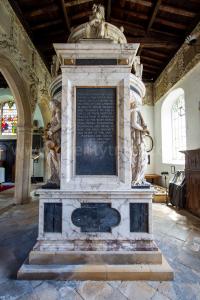
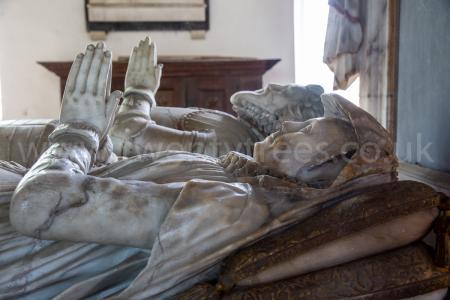
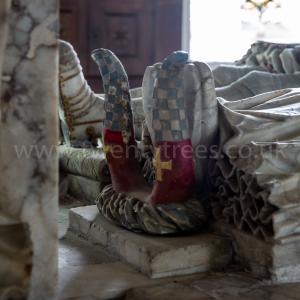
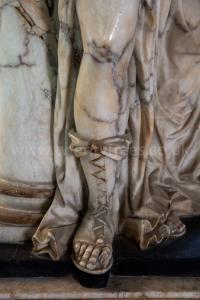
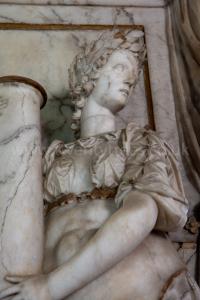

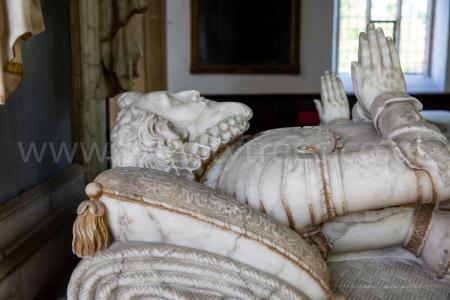
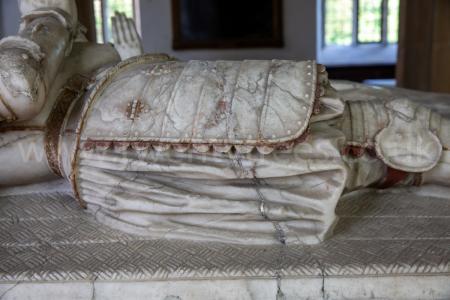
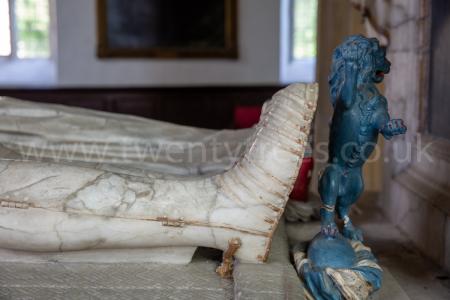
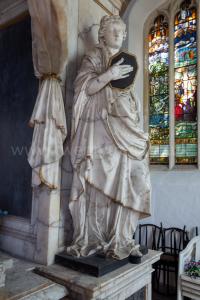
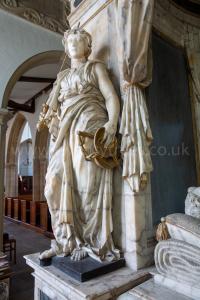
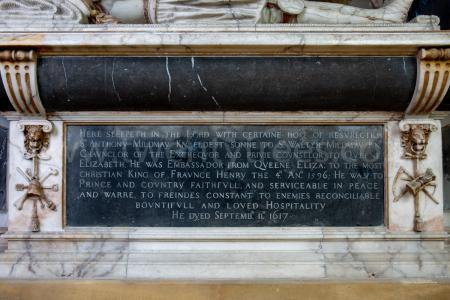
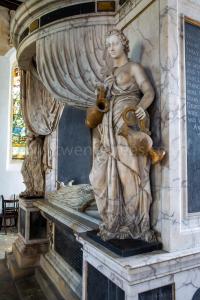
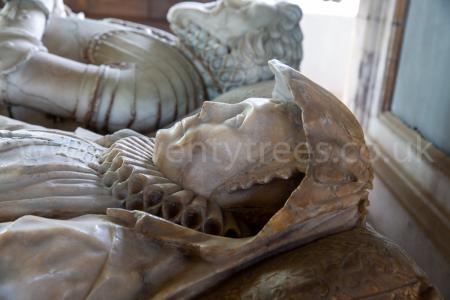
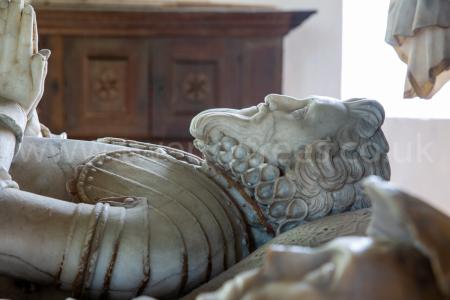
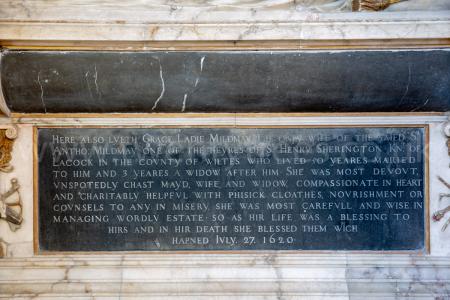
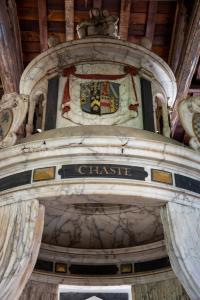
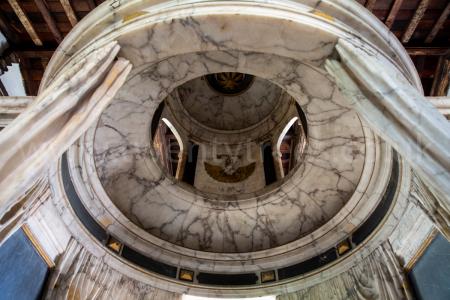
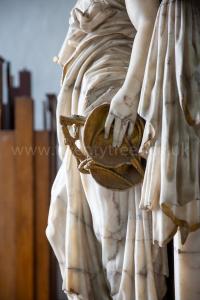
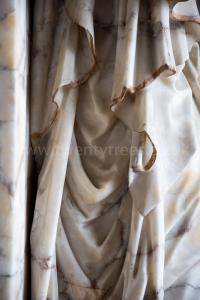
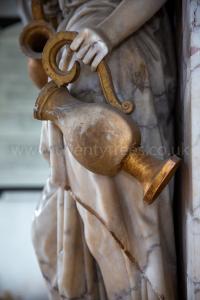
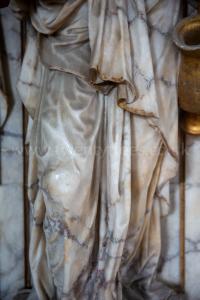
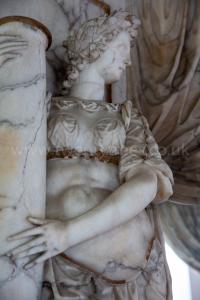
After 1627. Monument in the Church of St Leonard, Apethorpe [Map] to John Leigh -1627. Descended from the Leigh family of Addington. Grateful for further information as to his descent; email@twentytrees.co.uk.
Black marble panel flanked by Ionic columns supporting a frieze enriched with fruit and flowers, and an inverted broken pediment on which rest a reclining figure and a cartouche of arms of Leigh quartered with others
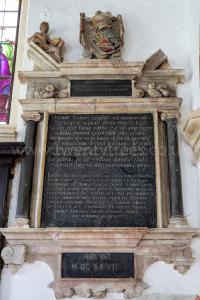
On 03 Sep 1634 Edward Coke (age 82) died. Monument in Church of St Mary the Virgin, Tittleshall [Map]. Simple sarcophagus on pedestal with lying effigy. Pair of flanking Tuscan columns supporting a full entablature with putti on frieze and broken segmental pediment. Carved and painted achievement in and above tympanum flanked by four reclining figures of the Virtues on pediment extrados.
Above. Quarterly of eight:  Coke Arms, Crispin, Folkard, Sparham, Nerford, Yarmouth,
Coke Arms, Crispin, Folkard, Sparham, Nerford, Yarmouth,  Knightley Arms and Pawe. The crest is broken. Farrer says it was: On a chapeau Azure, turned up Ermine, an ostrich Argent, holding in its mouth a horseshoe Or. The motto reads Prudens qui Patiens.
Knightley Arms and Pawe. The crest is broken. Farrer says it was: On a chapeau Azure, turned up Ermine, an ostrich Argent, holding in its mouth a horseshoe Or. The motto reads Prudens qui Patiens.
The effigy was carved by John Hargrave, the rest of the memorial was made by Nicholas Stone (age 47).
Below the effigy are three shields. Left  Coke Arms implaling
Coke Arms implaling  Paston Arms. His first wife Bridget Paston. Middle
Paston Arms. His first wife Bridget Paston. Middle  Coke Arms. Right
Coke Arms. Right  Coke Arms impaling
Coke Arms impaling  Cecil Arms; his second wife Elizabeth Cecil Countess Berkshire (age 38).
Cecil Arms; his second wife Elizabeth Cecil Countess Berkshire (age 38).

Bridget Paston: she was born to John Paston. On 13 Aug 1582 Edward Coke and she were married. She a great x 4 granddaughter of King Edward III of England.
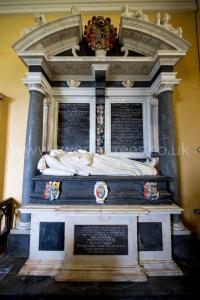
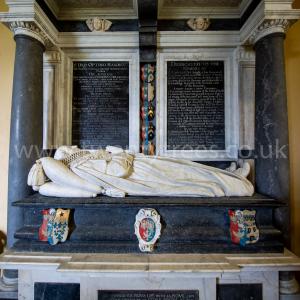
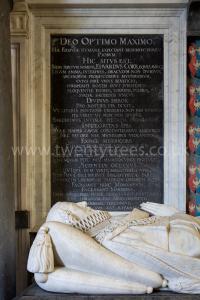
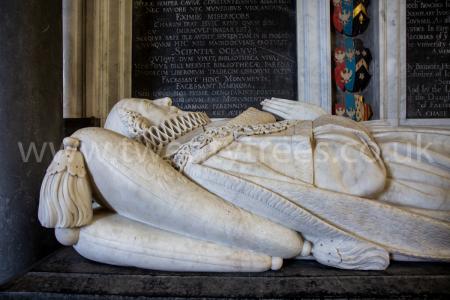
Evelyn's Diary. 25 Mar 1644. The whole town is handsomely built of that excellent stone so well known by that name in England. I was led to a pretty garden, planted with hedges of alaternus, having at the entrance a screen at an exceeding height, accurately cut in topiary work, with well understood architecture, consisting of pillars, niches, friezes, and other ornaments, with great curiosity; some of the columns curiously wreathed, others spiral, all according to art.
Evelyn's Diary. 04 Nov 1644. In the great hall are divers excellent paintings of Cavaliero Giuseppe d'Arpino, a statue in brass of Sextus V. and of Leo X., of marble. In another hall are many modern statues of their late Consuls and Governors, set about with fine antique heads; others are painted by excellent masters, representing the actions of M. Scævola, Horatius Cocles, etc. The room where the Conservatori now feast upon solemn days, is tapestried with crimson damask, embroidered with gold, having a state or balduquino of crimson velvet, very rich; the frieze above rarely painted. Here are in brass, Romulus and Remus sucking the wolf, of brass, with the Shepherd, Faustulus, by them; also the boy plucking the thorn out of his foot, of brass, so much admired by artists. There are also holy statues and heads of Saints. In a gallery near adjoining are the names of the ancient Consuls, Prætors, and Fasti Romani, so celebrated by the learned; also the figure of an old woman; two others representing Poverty; and more in fragments. In another large room, furnished with velvet, are the statue of Adonis, very rare, and divers antique heads. In the next chamber, is an old statue of Cicero, one of another Consul, a Hercules in brass, two women's heads of incomparable work, six other statues; and, over the chimney, a very rare basso-relievo, and other figures. In a little lobby before the chapel, is the statue of Hannibal, a Bacchus very antique, bustoes of Pan and Mercury, with other old heads. All these noble statues, etc., belong to the city, and cannot be disposed of to any private person, or removed hence, but are preserved for the honor of the place, though great sums have been offered for them by divers Princes, lovers of art, and antiquity. We now left the Capitol, certainly one of the most renowned places in the world, even as now built by the design of the famous M. Angelo.
Evelyn's Diary. 19 Nov 1644. The relics showed and kept in this church are without number, as are also the precious vessels of gold, silver, and gems, with the vests and services to be seen in the Sacristy, which they showed us. Under the high altar is an ample grot inlaid with pietra-commessa, wherein half of the bodies of St. Peter and St. Paul are preserved; before hang divers great lamps of the richest plate, burning continually. About this and contiguous to the altar, runs a balustrade, in form of a theater, of black marble. Toward the left, as you go out of the church by the portico, a little beneath the high altar, is an old brass statue of St. Peter sitting, under the soles of whose feet many devout persons rub their heads, and touch their chaplets. This was formerly cast from a statue of Jupiter Capitolinus. In another place, stands a column grated about with iron, whereon they report that our Blessed Savior was often wont to lean as he preached in the Temple. In the work of the reliquary under the cupola there are eight wreathed columns brought from the Temple of Solomon. In another chapel, they showed us the chair of St. Peter, or, as they name it, the Apostolical Throne. But among all the chapels the one most glorious has for an altar-piece a Madonna bearing a dead Christ on her knees, in white marble, the work of Michael Angelo. At the upper end of the Cathedral, are several stately monuments, especially that of Urban VIII. Round the cupola, and in many other places in the church, are confession seats, for all languages, Hebrew, Greek, Latin, Spanish, Italian, French, English, Irish, Welsh, Sclavonian, Dutch, etc., as it is written on their friezes in golden capitals, and there are still at confessions some of all nations. Toward the lower end of the church, and on the side of a vast pillar sustaining a weighty roof, is the depositum and statue of the Countess Matilda, a rare piece, with basso-relievos about it of white marble, the work of Bernini. Here are also those of Sextus IV. and Paulus III., etc. Among the exquisite pieces in this sumptuous fabric is that of the ship with St. Peter held up from sinking by our Savior; the emblems about it are the Mosaic of the famous Giotto, who restored and made it perfect after it had been defaced by the Barbarians. Nor is the pavement under the cupola to be passed over without observation, which with the rest of the body and walls of the whole church, are all inlaid with the richest of pietra-commessa, in the most splendid colors of polished marbles, agates, serpentine, porphyry, calcedon, etc., wholly incrusted to the very roof. Coming out by the portico at which we entered, we were shown the Porta Santa, never opened but at the year of jubilee. This glorious foundation hath belonging to it thirty canons, thirty-six beneficiates, twenty-eight clerks beneficed, with innumerable chaplains, etc., a Cardinal being always archpriest; the present Cardinal was Francisco Barberini, who also styled himself Protector of the English, to whom he was indeed very courteous.
Evelyn's Diary. 29 Nov 1644. I a second time visited the Medicean Palace, being near my lodging, the more exactly to have a view of the noble collections that adorn it, especially the bassi-relievi and antique friezes inserted about the stone work of the house. The Saturn, of metal, standing in the portico, is a rare piece; so is the Jupiter and Apollo, in the hall. We were now led into those rooms above we could not see before, full of incomparable statues and antiquities; above all, and haply preferable to any in the world, are the Two Wrestlers, for the inextricable mixture with each other's arms and legs is stupendous. In the great chamber is the Gladiator, whetting a knife; but the Venus is without parallel, being the masterpiece of one whose name you see graven under it in old Greek characters; nothing in sculpture ever approached this miracle of art. To this add Marcius, Ganymede, a little Apollo playing on a pipe; some relievi incrusted on the palace-walls; and an antique vas of marble, near six feet high. Among the pictures may be mentioned the Magdalen and St. Peter, weeping. I pass over the cabinets and tables of pietra commessa, being the proper invention of the Florentines. In one of the chambers is a whimsical chair, which folded into so many varieties, as to turn into a bed, a bolster, a table, or a couch. I had another walk in the garden, where are two huge vases, or baths of stone.
Evelyn's Diary. 21 May 1645. At the Mendicants are the Miracles of St. Eloy, by Reni, after the manner of Caravaggio, but better; and here they showed us that famous piece of Christ calling St. Matthew, by Annibal Caracci. The Marquis Magniani has the whole frieze of his hall painted in fresco by the same hand.
Evelyn's Diary. 07 Sep 1666. At my return, I was infinitely concerned to find that goodly Church, St. Paul's [Map] - now a sad ruin, and that beautiful portico (for structure comparable to any in Europe, as not long before repaired by the late King) now rent in pieces, flakes of large stones split asunder, and nothing remaining entire but the inscription in the architrave showing by whom it was built, which had not one letter of it defaced! It was astonishing to see what immense stones the heat had in a manner calcined, so that all the ornaments, columns, friezes, capitals, and projectures of massy Portland stone, flew off, even to the very roof, where a sheet of lead covering a great space (no less than six acres by measure) was totally melted. The ruins of the vaulted roof falling, broke into St. Faith's [Map], which being filled with the magazines of books belonging to the Stationers, and carried thither for safety, they were all consumed, burning for a week following. It is also observable that the lead over the altar at the east end was untouched, and among the divers. Monuments the body of one bishop remained entire. Thus lay in ashes that most venerable church, one of the most ancient pieces of early piety in the Christian world, besides near one hundred more. The lead, ironwork, bells, plate, etc., melted, the exquisitely wrought Mercers' Chapel, the sumptuous Exchange [Map], the august fabric of Christ Church [Map], all the rest of the Companies' Halls, splendid buildings, arches, entries, all in dust; the fountains dried up and ruined, while the very waters remained boiling; the voragos of subterranean cellars, wells, and dungeons, formerly warehouses, still burning in stench and dark clouds of smoke; so that in five or six miles traversing about I did not see one load of timber unconsumed, nor many stones but what were calcined white as snow.
Pepy's Diary. 08 Oct 1667. At last, rose, and up, and broke our fast, and then took coach, and away, and at Newport [Map] did call on Mr. Lowther (age 26), and he and his friend, and the master of the house, their friend, where they were, a gentleman, did presently get a-horseback and overtook us, and went with us to Audley-End [Map], and did go along with us all over the house and garden: and mighty merry we were. The house indeed do appear very fine, but not so fine as it hath heretofore to me; particularly the ceilings are not so good as I always took them to be, being nothing so well wrought as my Chancellor's (age 58) are; and though the figure of the house without be very extraordinary good, yet the stayre-case is exceeding poor; and a great many pictures, and not one good one in the house but one of Harry the Eighth, done by Holben; and not one good suit of hangings in all the house, but all most ancient things, such as I would not give the hanging-up of in my house; and the other furniture, beds and other things, accordingly1. Only the gallery is good, and, above all things, the cellars, where we went down and drank of much good liquor; and indeed the cellars are fine: and here my wife and I did sing to my great content.

Note 1. Mr. George T. Robinson, F.S.A., in a paper on "Decorative Plaster Work", read before the Society of Arts in April, 1891, refers to the ceilings at Audley End as presenting an excellent idea of the state of the stuccoer's art in the middle of James I's reign, and adds, "Few houses in England can show so fine a series of the same date ... The great hall has medallions in the square portions of the ceiling formed by its dividing timber beams. The large saloon on the principal floor-a room about 66 feet long by 30 feet wide-has a very remarkable ceiling of the pendentive type, which presents many peculiarities, the most notable of which, that these not only depend from the ceiling, but the outside ones spring from the walls in a natural and structural manner. This is a most unusual circumstance in the stucco work of the time, the reason for the omission of this reasonable treatment evidently being the unwillingness of the stuccoer to omit his elaborate frieze in which he took such delight" ("Journal Soc. of Arts", vol. xxxix., p. 449).
In 1710. John James Baker. Known as "Whig Junto". From www.tate.org ... This is a portrait of a political group named the Whig Junto and a Black servant, whose identity is unknown. It is the only known portrait of the Junto, which was an ideologically close-knit group of political peers who formed the leadership of the Whig party in the late seventeenth and early eighteenth centuries. The members of the group are shown gathered together on a grand terrace, while a vista onto a garden is revealed by the Black servant, who holds back a heavy velvet curtain. The grand architectural setting is imagined, and is deliberately evocative of power and status. The picture was commissioned by Edward Russell, 1st Earl of Orford (age 57), who stands on the right, as if welcoming the company. It is not known if Orford (age 57) had a Black servant in his household or whether the individual was included to emphasise Orford's (age 57) wealth and social standing. At the time, Britain was profiting heavily from the trade of enslaved people from West Africa. The presence of Black servants, many of whom were enslaved, in both aristocratic and merchant households had come to symbolise property and wealth. This reflected the dehumanising view of enslaved Black people held by the British elite.
The scene conjures one of the Junto's country house meetings where, in between parliamentary sessions, policy and party strategy were formulated. From left to right the sitters round the table can be identified as Charles Spencer, 3rd Earl of Sunderland (age 34); Thomas Wharton, 1st Marquess of Wharton (age 61); John Somers, 1st Baron Somers (1C 1697) (age 58); Charles Montagu, 1st Earl of Halifax (age 48); and William Cavendish, 2nd Duke of Devonshire (age 38). The lavish surroundings probably represent Orford's (age 57) house, Chippenham, where Junto meetings sometimes took place. It was also ideally located for the nearby Newmarket horse races, which the members of the Junto frequently attended when parliament was not sitting.



The portrait is dated 1710, before the crushing electoral defeat of the Whigs in October of that year. It shows the political allies while in power, when Sunderland (age 34) was Secretary of State, Wharton (age 61) Lord Lieutenant of Ireland, Somers Lord President of the Privy Council, Devonshire (age 38) Lord Steward and a member of the Privy Council, and Orford (age 57) First Lord of the Admiralty. On the surface the portrait shows a relaxed gathering of fellow connoisseurs, seated round a table consulting antique medals and books of prints. Fittingly, Somers and Halifax (age 48) sit at the centre of the company, holding a book and handling a medal respectively. Both were known collectors and antiquarians - Somers was one of the founders of the Whig Kit-Cat Club, a convivial drinking and dining club, but which also had a political propagandist agenda; he had also purchased the Resta collection of drawings from Italy in 1709. Halifax (age 48) had a celebrated library and a collection of antique medals (sold in 1740), to which those being consulted presumably allude. Behind this exterior of cultural appreciation, however, the portrait advertises Whig policy in 1709-10, which supported the continuation of war against France in opposition to Tory calls for peace. The two visible prints are friezes from Trajan's column showing episodes from the Dacian wars, with the Roman army crossing the Danube. The viewer is invited to make parallels between the valour and victories of the Roman emperors and the current military greatness achieved for Britain by the Duke of Marlborough's campaigns. The globe, showing the Pacific, presumably alludes to Whig foreign policy ambitions beyond Europe. By defeating France in Europe, they aimed to gain commercial access to Spanish American trade routes. It reflects the competitive European colonial pursuit of new markets, including the selling of enslaved West African people to Spanish territories overseas.



John James Baker (or Backer, or Bakker) is thought to have been Flemish, from Antwerp. He was Godfrey Kneller's (age 63) (1646-1723) long-time studio assistant and drapery painter, and this is his largest, most ambitious and complex work. The symbolic programme was presumably devised by Orford in discussion with Baker. The Duke of Devonshire was not a regular member of the Junto, although an increasingly important Whig peer, but his inclusion here is presumably because of his kinship relationship with Orford. The picture is thus a demonstration of Orford's private as well as professional networks, and also his pride and ambition. It would have been displayed at Chippenham in the newly appointed, fashionable interiors, alongside other works that Orford commissioned to advertise his public achievement and the private and professional networks that sustained his power and influence.
Before 1736. Monument to Anne Brudenell (wife of Charles Lennox) in St Peter's Church, Deene [Map] by Giovanni Battista Guelphi (age 45) on the west wall of the transept. Bust set against square surround with flanking caryatids, metope frieze and pediment over.
Giovanni Battista Guelphi: Church of St Peter Kirkthorpe. The chief merit of the church is a fine collection of C18 wall monuments. The most important of these is the Stringer Monument by Guelfi: 2 detached busts on a sarcophagus with straight tapering sides; background by Kent with inscription, a frame starting from 2 big volutes and crowned by an open-segmental pediment carved coat-or-arms with putti. The Smyth chapel has numerous monuments dating from 1731; including that to John Smyth of 2 putti uncovering his portrait on an oval medallion, that to Lady Georgina Smyth and others signed by Flaxman; 1799. Around 1690 he was born. In 1736 he died.
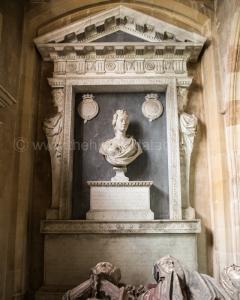
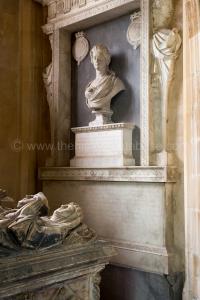
On 20 Jan 1770 Charles Yorke (age 47) died. He was buried at St Andrew's Church, Wimpole [Map]. Grey marble obelisk on break-front pedestal of white marble with inscription tablet flanked by festoons and frieze carved with emblems of the Chancellor's office; at the base of the obelisk two putti unveil a portrait medallion and at the apex is an achievement of arms; signed 'P. SCHEEMAKER (age 79) FaT'.
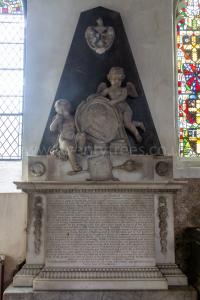
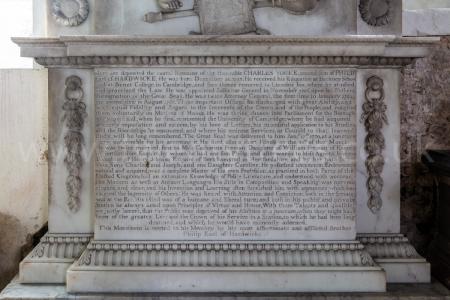
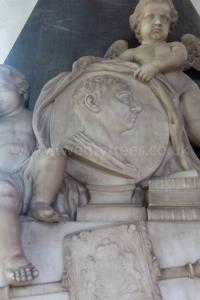
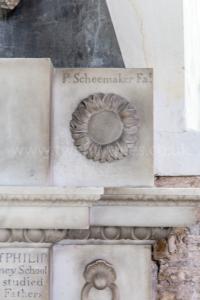
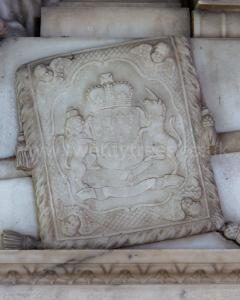
On 03 Mar 1848 Edward Hawkins Cheney (age 69) died. St Luke's Church Gaddesby, Leicestershire [Map]. Monument to Edward Hawkins Cheney (age 69) of the Royal Scots Greys fighting at Waterloo. His horse shot, collapsing; one of four he rode into battle. He survived the battle dying in 1845. The frieze below the sculpture depicts Sergeant Ewart, related to Cheney by marriage, seizing the French Eagle Standard. Sculpted by Joseph Gott (age 62).
Edward Hawkins Cheney: On 07 Nov 1778 he was born. On 18 Jun 1815 Edward Hawkins Cheney fought at the Battle of Waterloo.
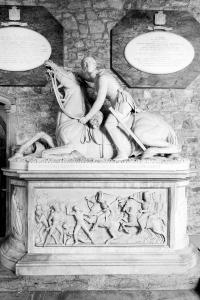
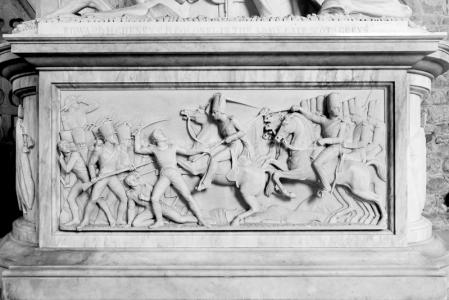

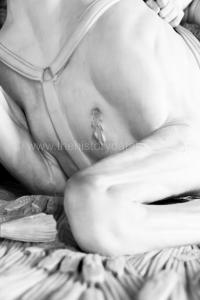
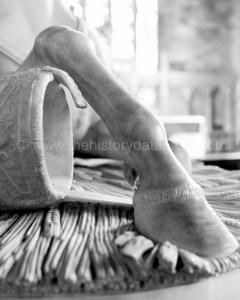
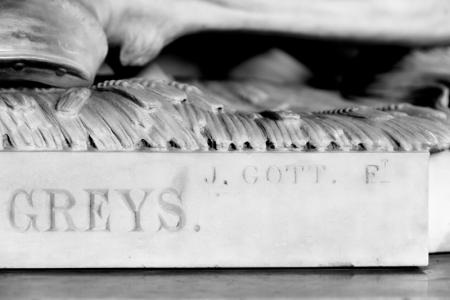
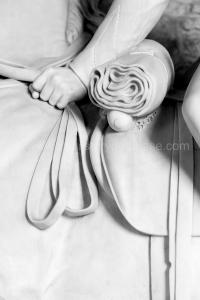
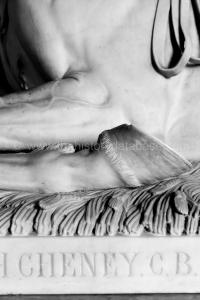
St Andrew's Church, Denton [Map]. In ashlar. The latin raised letter inscription is set in an egg and dart surround, flanked by Ionic Pilasters and free standing Composite fluted columns, supporting a pediment containing a pair of naked female figures holding hour glasses leaning on a skull. The frieze is decorated with medallions. The reclining figure of the deceased, his prayer book in hand, lies on a half rolled up mattress on a tomb chest on which are portrayed his wife and six children, all named in raised letters.
